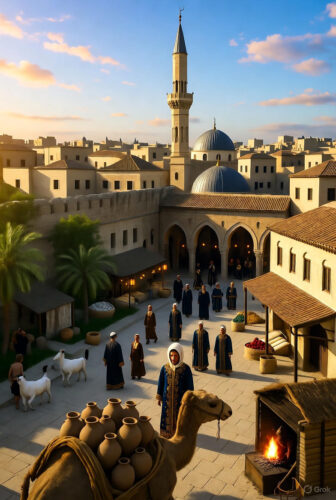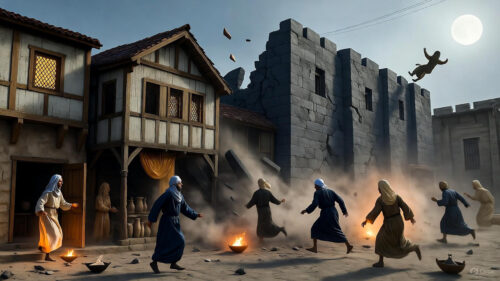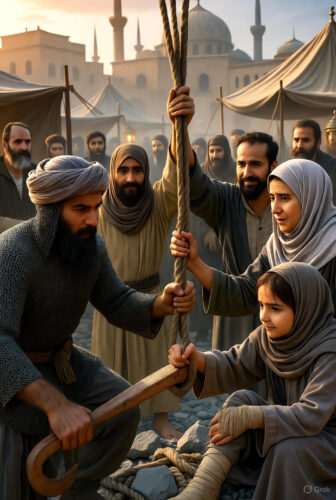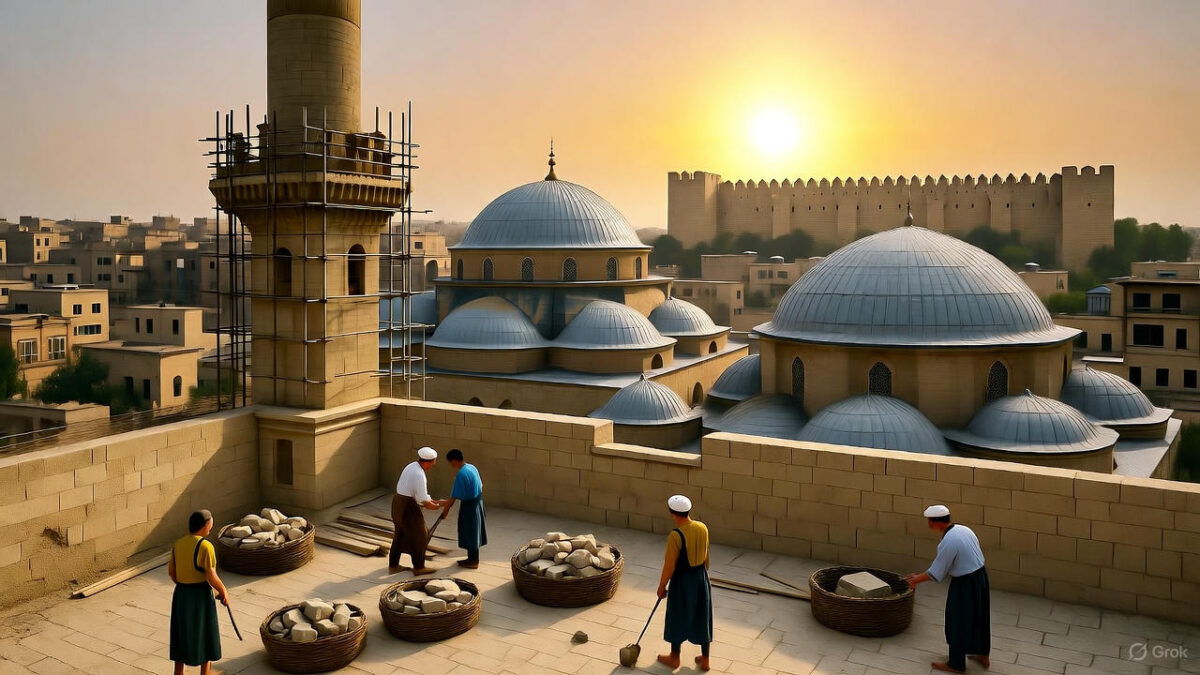Imagine a city pulsing with the raw energy of the 12th century, where the air carries the scent of spiced meats roasting over open flames, the distant clang of blacksmith hammers shaping swords for endless wars, and the call to prayer echoing from minarets that pierce the sky like defiant fingers. This was Aleppo in 1138, a crossroads of empires, a jewel in the crown of the medieval Near East, and unwittingly, the epicenter of one of history’s most ferocious natural assaults. On October 11, that year, the earth itself rose up in fury, shaking the foundations of stone and spirit alike. What followed was not just a catastrophe of crumbling walls and buried lives, but a testament to the unyielding thread of human endurance woven through time.
This isn’t a tale of dusty annals or forgotten footnotes; it’s a vivid plunge into a moment when nature scripted a tragedy that reshaped borders, beliefs, and the very soul of survival. We’ll wander the bazaars of pre-quake Aleppo, feel the tremor that tore through it, sift through the rubble of its aftermath, and emerge on the other side with stories that whisper across centuries. And because history isn’t just about what was, but what can be, we’ll draw lines from those shattered streets to the quiet corners of your own life – showing how the lessons of that long-ago rumble can fortify your steps today. Buckle up; this journey through time is as gripping as a desert storm and as inspiring as the dawn that follows.
## The Volatile Crucible: Aleppo in the Shadow of Crusades
To grasp the full weight of the 1138 earthquake, we must first step back into the swirling sands of the 12th century. Aleppo, perched in northern Syria like a sentinel overlooking the fertile plains of the Euphrates, was no sleepy outpost. Founded millennia earlier as a trading hub on the Silk Road, it had ballooned into a metropolis of perhaps 100,000 souls by the Middle Ages – a figure that rivals modern mid-sized cities. Its walls, fortified with double layers of basalt and limestone, encircled a labyrinth of souks where merchants haggled over silks from China, spices from India, and glassware from Venice. The Great Mosque, with its soaring minaret built in 1090, stood as a beacon of Islamic scholarship, its libraries stuffed with scrolls on astronomy, medicine, and poetry. Christians, Jews, and Muslims coexisted in a tense but vibrant mosaic, their faiths intertwined like the arabesques on the city’s ceramic tiles.
But peace was a fragile illusion. The year 1138 fell squarely in the heart of the Crusades, that epochal clash of iron and ideology that pitted European Christian kingdoms against the Muslim world. The First Crusade had captured Jerusalem in 1099, but the Levant simmered with retaliation. Aleppo itself had changed hands like a hot coal: conquered by the Seljuk Turks in the 11th century, then besieged by the Crusader states to the west. By 1138, the city was under the nominal control of the Zengid dynasty, a Turkish Muslim faction led by the cunning Imad al-Din Zengi, who dreamed of recapturing Edessa – the first Crusader state, just 100 miles away.
Zengi himself was a force of nature, a warrior-poet whose raids kept the Franks (as Muslims called the Crusaders) in perpetual dread. Born around 1085, he had risen from atabeg (governor) of Mosul to lord of Aleppo by 1128, forging alliances through marriage and murder. His court buzzed with spies, scholars, and soldiers; chroniclers like Ibn al-Athir later described him as “a lion in battle, a fox in council.” Yet even Zengi’s iron grip couldn’t quell the undercurrents of unrest. Famine stalked the land after poor harvests, and plague had swept through in 1137, claiming thousands. The region’s fault lines – both geological and political – were primed to snap.
Beyond the city walls, the landscape was a tapestry of peril. To the north lay the Crusader Principality of Antioch, ruled by the hot-headed Raymond of Poitiers, whose knights clad in chainmail patrolled the hills. To the east, Byzantine envoys from Emperor John II Komnenos schemed to reclaim lost territories, their golden solidi buying loyalties. And south, the Fatimid Caliphate in Egypt eyed the chaos for opportunity. Aleppo’s citadel, perched on a hill like a brooding eagle, was a marvel of engineering: 50 meters high, with ramparts thick enough to withstand catapults, it housed Zengi’s treasury and harem. Little did its defenders know that the greatest siege would come from below.
Daily life in this tinderbox was a blend of splendor and strain. Dawn broke with the adhan, the call to prayer, as muezzins climbed the minarets. Bakers fired up tabun ovens, producing flatbreads scented with sesame and nigella seeds. Children chased goats through alleys lined with date palms, while women in flowing abayas fetched water from aqueducts fed by the Quweiq River. Merchants like Abu al-Faraj, a fictional but representative silk trader, might start his day bartering with Frankish pilgrims for Frankish wool, only to end it dodging tax collectors. Evenings brought storytelling in the hammams, where steam rose like genies from heated floors, and tales of Harun al-Rashid mingled with whispers of Zengi’s latest victory.
Yet omens abounded. In the weeks before October 11, minor tremors – foreshocks, in modern terms – rattled teacups and unnerved the ulama, the religious scholars. Arab astrologers consulted the stars, warning of celestial alignments portending doom. Usama ibn Munqidh, a knight-poet exiled nearby, later recounted in his memoirs how “the earth groaned like a wounded beast.” These were dismissed as divine tests, much like the wars that scarred the soul. No one could foresee that the true beast was awakening along the Dead Sea Transform fault, a 1,000-kilometer scar where the Arabian and African plates ground against each other, building pressure for centuries.
This was Aleppo: a phoenix in waiting, forged in fire, ready to be tested by an inferno from the depths.
## Whispers of Warning: The Calm Before the Cataclysm
October 10, 1138, dawned clear and crisp, the autumn sun gilding the Euphrates in hues of amber. In the citadel, Zengi convened his war council, maps unrolled across carpets woven with threads of gold. Scouts reported Crusader movements near Harim, a fortress 30 miles west, where Raymond’s forces massed for a potential strike. “We strike first,” Zengi declared, his voice like gravel under boot. Orders flew: archers to sharpen arrows fletched with goose feathers, smiths to temper blades in vinegar baths. Down in the city, life flowed unabated. The suq al-kabir, the grand market, teemed with hagglers – a Jewish physician peddling theriac (a universal antidote of 70 ingredients), a Coptic Christian selling beeswax candles for the churches.
But beneath the bustle, unease stirred. That morning, a foreshock – magnitude perhaps 5.0 – rippled through the valley. Wells sloshed, hanging lamps swung in the Great Mosque, and a few clay jars shattered in potters’ stalls. “Allah’s reminder,” murmured an old dervish, his tasbih beads clicking like dice. Chronicler Ibn al-Qalanisi, writing from Damascus years later, noted how “the ground trembled as if in prayer, but we paid it no heed, for war was our true quake.” Families gathered for iftar-like suppers early, dates and yogurt under olive trees, sharing tales of resilience. A young apprentice, let’s call him Khalid, might have joked with his master about the “earth’s hiccup,” unaware it heralded the convulsion.
As night fell, stars wheeled overhead in a sky unmarred by city lights. Zengi’s guards patrolled the ramparts, torches sputtering against the chill. In the Jewish quarter, rabbis pored over Talmudic texts by oil lamp, debating earthquakes as signs of the Messiah. Christian monks in the Cathedral of St. Helena chanted vespers, their Latin hymns mingling with Arabic lullabies from neighboring homes. Sleep came fitfully; dogs howled at shadows, and in the distance, jackals yipped from the hills. The fault line, silent for generations, stored energy equivalent to 15 Hiroshima bombs, its release imminent.
Historians today, using seismology, peg the epicenter near Aleppo, perhaps 10 kilometers south, along a branch of the Dead Sea fault. The quake’s mechanics were brutal: a strike-slip rupture, where plates slid horizontally, unleashing waves that propagated at 6 kilometers per second. But to the people of 1138, it was the wrath of djinn or the footfall of giants. Little did they know, this was no isolated fury; aftershocks would rumble for months, a grim coda to the symphony of destruction.
## The Roar from Below: When the World Unraveled
At around 4 a.m. on October 11, as the first threads of dawn teased the horizon, it began. Not with a bang, but a guttural growl – the earth belching forth pent-up rage. The initial jolt, estimated at magnitude 7.5 to 8.5, lasted 30 seconds but felt eternal. In Aleppo, the citadel’s massive walls – 20 meters thick at the base – buckled like parchment in flame. Towers toppled, crushing barracks where soldiers slumbered, their cries swallowed by the din of grinding stone. The Great Mosque’s minaret, that proud 45-meter spire, twisted and fell, its debris felling worshippers in mid-prostration.
Streets became rivers of ruin. The double walls, engineered by Byzantine architects a century prior, fractured along mortar lines, segments sliding into moats filled with debris. Houses of mud-brick and timber, home to the city’s dense populace, imploded inward, trapping families in tangles of beams and plaster. The suq al-kabir, with its vaulted ceilings, collapsed in a cascade of silk bolts and shattered amphorae, spices clouding the air like blood in water. Ibn al-Qalanisi described it vividly: “The very foundations of the earth were upturned; domes fell upon their inhabitants, and the minarets upon the markets.”
The human toll was apocalyptic. Estimates, drawn from medieval sources like al-Maqdisi and modern analyses, hover at 230,000 dead across the region – a figure that staggers, equivalent to wiping out Paris’s population thrice over. In Aleppo alone, perhaps 100,000 perished, many in the pre-dawn hours when sleep masked the peril. Bodies piled in alleys, limbs protruding from rubble like accusing fingers. The Quweiq River, choked with corpses and wreckage, ran red, its waters undrinkable for weeks.
The quake’s reach was vast, a 300-kilometer swath of devastation. Thirty miles west, at Harim, the Crusader citadel – a squat fortress built by the Normans in 1109 – suffered catastrophically. Its church collapsed mid-mass, killing knights and their squires; the keep’s curtain walls sheared off, plummeting 50 meters to bury outbuildings. Raymond of Poitiers, roused from his bed in Antioch, 60 miles north, felt the aftershocks and dispatched riders, only to find his allies decimated. Ma’arrat al-Nu’man, 30 miles south, saw its famed libraries – repositories of Greek texts translated by Hunayn ibn Ishaq centuries earlier – reduced to ash from toppled braziers. Even distant Shaizar, 50 miles southeast, lost its bridge over the Orontes, stranding Zengi’s reinforcements.
Eyewitness accounts, pieced from fragments, paint visceral scenes. Usama ibn Munqidh, encamped nearby, recalled “the sky darkening as dust rose like a shroud, and screams piercing the thunder of falls.” A merchant’s wife, surviving by chance under a arched doorway (an instinctive brace position unknown then), clawed free to find her home a tomb. Animals fared no better: camels stampeded through gates, elephants in Zengi’s menagerie trumpeted in terror before their stalls caved. Fires erupted from overturned lamps, but the dust-choked air smothered most, leaving a landscape of smoldering pyres.
Geologically, this was a masterpiece of malice. The rupture propagated bilaterally, unleashing P-waves that cracked bedrock and S-waves that liquefied soil under the city’s outskirts. Landslides buried villages along the foothills, and in the plains, fissures yawned 10 meters wide, swallowing olive groves whole. The aftershock on October 12, nearly as strong, compounded the horror, toppling what little stood. For days, the sun hid behind veils of pulverized limestone, turning noon to twilight. This was no mere shake; it was the earth rewriting its script, indifferent to the empires it humbled.
## Dust and Despair: Navigating the Labyrinth of Loss
As the tremors ebbed into uneasy stillness, Aleppo awoke – or rather, what remained of it stirred – to a world remade in nightmare. Dawn revealed a city as if sifted through a sieve of giants: minarets reduced to stubs, bazaars to graveyards of goods, the citadel a jagged scar against the sky. Dust hung thick, coating lungs and eyes, while the acrid tang of crushed gypsum mingled with the coppery scent of blood. Survivors, dazed and dust-caked, emerged from pockets of fortune – arched gateways, open courtyards, or the rare stone vault that flexed but held.
The human drama unfolded in raw, unfiltered strokes. Zengi, spared by the citadel’s partial survival, rallied his emirs from a makeshift tent, his face etched with grief and grit. “We rebuild not for stone, but for the ummah,” he proclaimed, though privately, chroniclers say he wept for his drowned dreams. Riders fanned out to Antioch and Damascus, begging aid; but roads cracked like eggshells, delaying caravans. In the streets, the living became scavengers of fate. Groups formed spontaneously – families, neighbors, even former foes – wielding adzes and bare hands to pry at the deadfall.
Death was omnipresent, a shroud over the senses. Bodies, twisted in final agony, bloated under the sun, drawing flies in biblical swarms. Burial details, improvised from surviving imams and priests, worked feverishly, wrapping the fallen in salvaged shrouds before lime pits swallowed them whole. Water, the lifeblood, was poisoned; the Quweiq’s flow halted by debris dams, forcing foragers to trek miles to springs. Famine loomed as granaries burst, spilling wheat into the mud. Disease followed swift: dysentery from tainted wells, crush injuries festering into gangrene. Ibn al-Athir tallied “plagues upon plagues,” with survivors coughing blood from inhaled particulates.
Yet amid the mausoleum, flickers of the human spark endured. Stories abound of quiet heroism: a baker sharing his last loaves with orphans, a Frankish knight aiding Muslim widows despite the truce’s fragility. Women, often overlooked in annals, led much of the toil – binding wounds with torn hijabs, boiling herbs for poultices. Children, those small sentinels of hope, scavenged toys from ruins: a doll’s head, a toppled chess piece. Zengi’s physicians, drawing on Avicenna’s Canon of Medicine, set bones with splints of bamboo and acacia, brewing antidotes from myrrh and opium. Even animals pitched in; donkeys hauled rubble, their brays a mournful counterpoint to hammers.
The quake’s ripple extended geopolitically. Crusaders, their Harim garrison halved, postponed offensives; Raymond licked wounds in Antioch, his coffers drained by ransoming survivors. Zengi seized the chaos, launching probes that recaptured fringe outposts, his propaganda framing the disaster as divine favor against infidels. Byzantine envoys, arriving with grain ships, extracted oaths of fealty, weaving Aleppo tighter into Constantinople’s web. Economically, the Silk Road stuttered; camel trains detoured, prices for Levantine figs and dyes soaring in Cairo’s markets.
For weeks, aftershocks – over 50 recorded – kept terror fresh. Each rumble sent crowds bolting to open fields, where tents sprouted like mushrooms. Psychologically, the event scarred deep: nightmares of swallowing earth, omens read in every creak. Poets like al-Kamil later elegized it: “The ground, once mother, turned devourer; from her womb, we clawed to light.” This phase, the grinding aftermath, tested sinews and souls, forging legends from lament.
## Threads of Tenacity: Rescue, Recovery, and the Dawn of Renewal
Rescue in 1138 was primal, a race against entropy armed with ingenuity and desperation. No cranes or floodlights; just levers of olive wood, ropes of hemp, and the lever of community. Dawn brigades formed at muezzin calls, neighbors linking arms to lift beams that pinned the living. “Listen for the moans,” elders advised, ears to stone yielding faint knocks from voids. Successes were euphoric: a child pulled gasping from a crevice, a scholar emerging with his inkpot intact. Failures, heartbreaking: false hopes dashed on silent forms.
Zengi’s administration, battered but bureaucratic, coordinated from a hilltop pavilion. Scribes tallied the lost – 40,000 homes gone, half the walls breached – while quartermasters distributed rice from royal stores. Aid trickled in: Damascus sent 500 camels laden with tents and dates; Mosul, bolts of cloth for bandages. Even Crusaders contributed surreptitiously, barrels of wine and salted fish crossing lines under white flags. Physicians innovated on the fly: trepanning skulls to relieve pressure from falls, using leeches for swelling. Herbalists brewed tisanes of thyme and honey, staving off cholera’s creep.
As days blurred to weeks, the focus shifted to salvage. Artisans sifted rubble for reusable stone, their chants rhythmic as they stacked. The Great Mosque’s ruins yielded fragments of Korans, pages kissed and reburied with honors. Markets improvised in plazas, bartering trinkets for bread – a brass ewer for a fistful of lentils. Children, resilient weeds, organized games amid scaffolds, their laughter a balm. Women wove mats from palm fronds, birthing a cottage industry that echoed for generations.
Rebuilding commenced with fervor, a phoenix’s laborious rise. Zengi poured dinars into masons, who layered new walls with lessons learned: wider foundations, flexible joints inspired by Persian designs. The citadel rose stronger, its towers now braced with iron ties. By 1140, the minaret reborn soared higher, a symbol of defiance. Economically, the quake spurred innovation; aqueducts rerouted for resilience, granaries elevated on stilts. Culturally, it birthed a renaissance: scholars like al-Sarraj documented the event, blending seismology with theology – earthquakes as Allah’s forge, tempering faith.
The legacy rippled outward. The weakened Crusader front eased pressure, allowing Zengi his 1144 triumph at Edessa, a quake-fueled pivot in Crusade fortunes. Aleppo emerged tighter-knit, its diverse populace bound by shared scars. Centuries later, Ibn Battuta would praise its “unconquerable spirit,” a nod to 1138’s forge.
This chapter, from clawing free to crafting anew, reveals humanity’s core: not the fall, but the stand.
## Forged in Fracture: The Broader Echoes Across Empires
The 1138 quake wasn’t an isolated thunderclap; its shockwaves reverberated through the medieval world, altering trajectories in ways subtle yet seismic. Politically, it decapitated local powers: Zengi’s rivals in Shaizar lost their prince, drowned in the Orontes’ surge, clearing his path to hegemony. The Crusader states, their citadels cracked, faced a respite – but one that bred complacency, culminating in Saladin’s later sweeps. Byzantium, sensing weakness, dispatched engineers to “advise” on fortifications, embedding spies who mapped faults for future plays.
Economically, the Levant stuttered. Trade routes, pockmarked by craters, saw caravans thin; Damascus merchants monopolized reroutes, amassing fortunes. Yet innovation bloomed: Syrian glassblowers, losing kilns, pioneered cooler-firing techniques, exporting wares that dazzled European courts. Agriculture rebounded with zeal; farmers terraced hills anew, channeling springs to irrigate quake-scarred fields, boosting pistachio yields that fed caliphs for decades.
Scientifically, the event seeded inquiry. Arab polymaths like al-Biruni had theorized subterranean fires; post-1138, treatises proliferated. Al-Qazwini, in his 13th-century Wonders of Creation, cited Aleppo as proof of “the earth’s hidden fires,” predating modern plate tectonics by 800 years. Theologically, it sparked debates: Was it punishment for sin, or trial of faith? Sufi mystics spun parables of rebirth, influencing Rumi’s later whirling dervishes.
Socially, fractures healed with fresh mortar. Interfaith aid forged bonds; a mosque funded by Frankish tithes, a church sheltering Muslims. Women gained ground, managing households turned workshops. Children, witnesses to wonder, grew into storytellers, perpetuating oral histories that outlasted stone.
Globally, echoes faint but felt: European chronicles, via pilgrims, noted “the Syrian cataclysm,” inspiring monastic prayers. In China, Silk Road tales arrived as “the western tremor,” correlating with a 1139 comet sighting. Thus, 1138’s rumble, though local in epicenter, was universal in lesson – nature’s reminder that empires, like earth, shift.
## From Ancient Ashes to Modern Anchors: Harvesting Resilience for Your Path
Now, pivot from the past’s pyre to the present’s potential. The Aleppo quake, with its cascade of collapse and climb, isn’t mere history; it’s a blueprint for personal fortitude. In a world of unforeseen upheavals – job losses, health scares, relational quakes – its outcomes teach that survival hinges not on prediction, but preparation and pivot. The unyielding spirit of those 12th-century survivors? It’s your inheritance, a motivational forge to temper daily grit. More than inspiration, it’s actionable: here’s how to apply this historical hammer to life’s anvil, with specifics to build your unbreakable core.
– **Cultivate Instinctive Anchors: Just as arched doorways spared lives by distributing force, identify your “structural braces” in chaos.** Stock a 72-hour emergency kit with non-perishables (canned beans, nuts for 2,100 calories daily), a multi-tool for improvised levers, and a whistle for signaling – tested monthly. In emotional quakes, anchor with a “resilience ritual”: five deep breaths visualizing Zengi’s rally, grounding panic into plan.
– **Forge Community Levers: Aleppo’s rescues thrived on collective muscle; solo efforts crumbled.** Map your “Zengi circle” – three neighbors for skill-shares (one medic-trained, one mechanically minded) – and drill a quarterly “rubble roundtable” over coffee, brainstorming scenarios from floods to fallouts. Digitally, join apps like Nextdoor for virtual vigils, turning acquaintances into allies before the aftershock hits.
– **Harvest from the Rubble: Salvage wasn’t scavenging; it was strategy, reusing stone for stronger walls.** Audit post-crisis: After a setback, list three “debris assets” – skills honed (e.g., negotiation from haggling losses), networks expanded (contacts from shared strife). Channel them: If a layoff buries your career, repurpose project management chops into freelance gigs via Upwork, aiming for three pitches weekly.
– **Innovate Through Aftershocks: Aleppo’s engineers widened foundations; you widen adaptability.** Post-disaster, prototype “fault-proof” habits: Track triggers in a journal (e.g., stress spikes at 3 p.m.), then iterate – swap coffee for chamomile walks. For finances, build a “seismic fund”: 3-6 months’ expenses in a high-yield savings, auto-deposited biweekly, echoing granary elevations.
– **Weave Narratives of Renewal: Poets turned trauma to tapestry; you turn trials to triumphs.** Craft a “quake chronicle”: Weekly, pen one lesson from a stumble (e.g., “Betrayal taught boundary-setting”), reading aloud to affirm growth. Share in a mastermind group, transforming personal pyre into communal phoenix.
### Your 30-Day Quake-Proof Plan: From Shaken to Steadfast
This isn’t abstract; it’s a step-by-step blueprint, drawn from Aleppo’s arc, to embed resilience in 30 days. Commit daily – track in a notebook, celebrate milestones with a favored treat.
**Week 1: Assess the Fault Lines (Preparation Phase)**
– Day 1-2: Inventory vulnerabilities – health, home, heart. List top three risks (e.g., power outage, isolation); research mitigations (backup generator? Therapy app?).
– Day 3-4: Assemble your kit, as above; test by simulating a 24-hour blackout.
– Day 5-7: Connect – host a casual chat with your circle, sharing one “fores hock” fear each.
**Week 2: Simulate the Surge (Response Drill)**
– Day 8-10: Role-play quakes: Time a 60-second “drop, cover, hold” under a table; debrief what felt shaky.
– Day 11-12: Practice salvage – declutter a drawer, repurposing items (old shirt to cleaning rag).
– Day 13-14: Innovate one habit: If procrastination quakes your workflow, trial Pomodoro (25-min sprints) for tasks.
**Week 3: Navigate the Aftermath (Recovery Forge)**
– Day 15-17: Journal a past “tremor” – what collapsed, what endured? Extract two assets.
– Day 18-19: Aid others – volunteer an hour (soup kitchen, online forum), feeling the lever lift.
– Day 20-21: Bolster buffers – deposit $50 into your fund; walk a new route, widening mental maps.
**Week 4: Rise Renewed (Rebuild Radiant)**
– Day 22-24: Chronicle a mini-win daily, weaving into a “renewal mantra” (e.g., “From rubble, I rise”).
– Day 25-26: Prototype big: Pitch that idea, mend that rift – act as if aftershocks are applause.
– Day 27-28: Reflect in circle – share progress, absorb theirs.
– Day 29-30: Celebrate – hike a hill (echoing citadel views), toast to tenacity. Review: What’s fortified? Adjust for life’s next rumble.
This plan, rooted in 1138’s grit, transforms history’s horror into your horizon’s hope. You’ve got the blueprint; now build.
In closing, the Aleppo quake reminds us: The ground may shift, but the human stride adapts. From its depths, we draw not fear, but fire – a motivational blaze to light our way. History, after all, is the ultimate coach, whispering, “You’ve survived worse; now thrive.”

